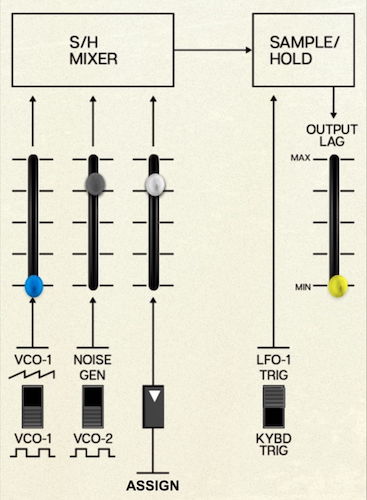Sample/Hold was a common option for modular synthesizers from the very beginning, but ARP popularized its use on smaller synthesizers like the 2600 and Odyssey. To understand its significance – and learn enough about it to use it effectively – we'll answer a few basic questions about it.
What does it do?
A sample and hold does exactly what it says on the label: it samples an incoming voltage, usually one that is varying rapidly, and holds that voltage level at its output until it's time to sample and hold again. The results can cover a wide range of applications, and depend on two things:
What signal is being sampled, and
How the circuit is triggered to take another sample and hold it until the next one.
What do we use it for?
By far the most common use of a sample and hold is to sample a noise generator, and trigger the circuit to resample based on either
the rate of an oscillator, or
pressing a note on the keyboard.
This samples a constantly-changing input, and holds "snapshots" of whatever voltage it happens to be at the moment the LFO cycle starts or a key is pressed, until the next LFO cycle or keypress. In other words, a sample and hold is the most common way to create a random voltage, either clocked to an LFO or taken whenever you play a note.
At lower LFO frequencies, this produces the rapidly-changing pitch effect often associated with computers in old sci-fi movies. At higher frequencies, it produces a very specific sort of frequency modulation.
When triggered with a keypress, sample and hold can modulate one or more elements of a sound so that it's slightly different with every note you play. This adds a touch of lively variety and interest to melodies, etc.
How does this one work?
The Sample/Hold on ODC 2800 actually isn't a lot different than the one on the original Odyssey.
S/H Mixer- Up to three input signals, two of them found on the original hardware, are sent to the S/H Mixer and blended to form the sampled signal.
Input 1 can either be the sawtooth or pulse wave from VCO 1
Input 2 can either be the noise generator or the pulse wave from VCO 2
Input 3 (exclusive to the software) is freely assignable from the pop-up modulation menu.
For "classic" random voltages, just set Input 2 to the Noise Generator and feed it through the S/H Mixer alone. However, if you select different waveforms for multiple inputs, especially if Input 1 is set to use the VCO 1 sawtooth while VCO 1 is being run in low-frequency (LF) mode, you can generate some very interesting repeating patterns.
LFO 1/KYBD TRIG- The Sample/Hold is then triggered by one of two sources: either LFO 1 or key presses.
Output Lag- Before the Sample/Hold output voltage is made available as a modulator, you have the option to feed it through a lag processor, which slows down the movement from voltage to voltage so it doesn't happen instantaneously. Think of it as working like Glide – which is simply a lag processor applied to the control voltage sent by the keyboard – but can be applied to any sort of modulation voltage.
One more question:
How do you write it?
When looking at the front panel and then reading the user manual for the ARP Odyssey, then doing the same for many other synthesizers, you couldn't be blamed for asking: is it "Sample/Hold", "sample and hold", "Sample and Hold", "Sample & Hold", or "Sample-Hold"? And do you abbreviate it "S-H", "S&H", "S+H", or "S/H"?
The answer is "Yes, all of the above." While everyone disagrees on how to write it (the Odyssey itself does it three or four different ways), everyone agrees on what it does – and it let the Odyssey, and now ODC 2800, do things most other synthesizers couldn't.
